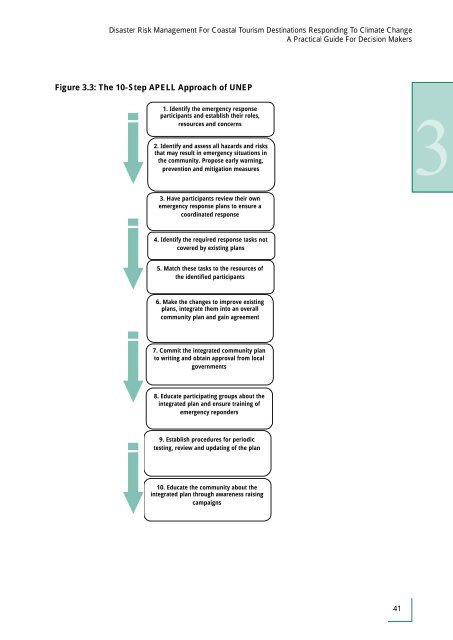Disaster Risk Management For Coastal Tourism Destinations - DTIE
Disaster Risk Management For Coastal Tourism Destinations - DTIE
Disaster Risk Management For Coastal Tourism Destinations - DTIE
Create successful ePaper yourself
Turn your PDF publications into a flip-book with our unique Google optimized e-Paper software.
<strong>Disaster</strong> <strong>Risk</strong> <strong>Management</strong> <strong>For</strong> <strong>Coastal</strong> <strong>Tourism</strong> <strong>Destinations</strong> Responding To Climate Change<br />
A Practical Guide <strong>For</strong> Decision Makers<br />
Figure 3.3: The 10-Step APELL Approach of UNEP<br />
1. Identify the emergency response<br />
participants and establish their roles,<br />
resources and concerns<br />
2. Identify and assess all hazards and risks<br />
that may result in emergency situations in<br />
the community. Propose early warning,<br />
prevention and mitigation measures<br />
3<br />
3. Have participants review their own<br />
emergency response plans to ensure a<br />
coordinated response<br />
4. Identify the required response tasks not<br />
covered by existing plans<br />
5. Match these tasks to the resources of<br />
the identified participants<br />
6. Make the changes to improve existing<br />
plans, integrate them into an overall<br />
community plan and gain agreement<br />
7. Commit the integrated community plan<br />
to writing and obtain approval from local<br />
governments<br />
8. Educate participating groups about the<br />
integrated plan and ensure training of<br />
emergency reponders<br />
9. Establish procedures for periodic<br />
testing, review and updating of the plan<br />
10. Educate the community about the<br />
integrated plan through awareness raising<br />
campaigns<br />
41

















